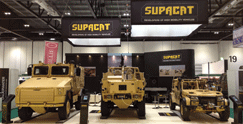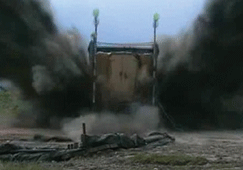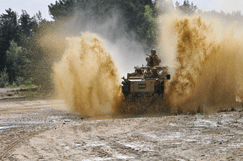In the north Devonshire countryside, in a location 850 feet above sea level and alongside two Second World War airfields at Dunkeswell Aerodrome, lies Supacat.
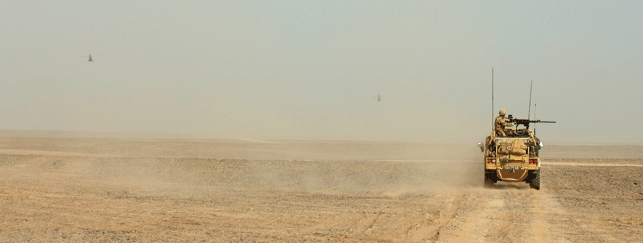
Jackal 1 (HMT400) with the Royal Marines on operations
The building may look unassuming but it’s here where the design, development, prototyping, testing and manufacture of its military and other specialist products takes place.
Soon after it was founded in 1981, Supacat launched its first military vehicle, the All-Terrain Mobility Platform (ATMP). This 3,450kg 6×6 workhorse is still used today in a wide variety of roles worldwide, including air crash recovery and fire fighting.
Supacat’s range of off-road wheeled and tracked vehicles has since expanded and its High Mobility Transporter (HMT) series now includes HMT400, HMT600 and the HMT ‘Extenda’ configurations.
The two former vehicles are probably best known as Jackal and Coyote, so named by its client the UK Ministry of Defence (MOD), which currently has these vehicles in operation by British Armed Forces in Afghanistan.
The more recent additions to its portfolio include the Supacat Protected Vehicle 400 (SPV400) series with its V-shaped hull and composite crew pod to provide mine blast and ballistic protection, and the Light Reconnaissance Vehicle 400 (LRV400).
The latter, launched during the summer, is a different approach to designing a military vehicle in that Supacat has partnered with the race vehicle designers, Qt Services, to turn its successful ‘Wildcat’ off-road motor sport vehicle into a low cost, highly mobile and lightweight military vehicle.
One stop shop
Supacat consists of 110 people, a third of which are engineers, and operates a complete engineering cycle from concept through to production as well as continuous development and through life support. With a range of workshop and factory facilities, it has the capability in-house to build one HMT style truck per week.
Being so specialist, these products spend a long time in design and development, not least of all for all the parts they contain.
“For the Coyote truck (6×6) we have the following breakdown: Full vehicle drawing pack – 2,200+ drawings (parts and assemblies) consisting of unique 5,500 parts and assemblies, 18,000 individual parts in the bill of materials. This, however, does not include MOD specific fit items like communications kits, weapons, ammunition etc.,” explains Dr Jonathan Farley, Supacat’s principal systems engineer.
All of the drawings and assemblies are done in SolidWorks, of which there are 20 seats in-house. However, the design and engineering teams aren’t only involved in bringing the products into the 3D world on their computer screens but they also get to drive the final products in the real world.
“We are believers in making sure that the designers get to use the vehicles as well. It helps with the passion – you see it drawn, made and then you can test and use it – but it also helps them to see how any changes made on screen affect the driveability and maintainability of the vehicles,” says Jamie Clarke, Supacat’s head of marketing & communications.
“Doing this may also allow them to see what improvements can be made, especially by talking to the users. We feel it’s good for the guys to meet with the users and talk to them directly about the vehicles and understand what they want,” adds Farley. “We have a great working relationship with all of the users of our vehicles which helps us to understand what they do and we also try get involved in their trials too.”
Transferring skills
Like Farley, quite a lot of the design and engineering team come from an automotive background and as such quite a lot of automotive technology is employed in the vehicles such as responsive steering and tight turning circles.
“I think one of Supacat’s strengths is that we have taken skill sets from a different sector and applied it into a military product where the majority of military products tend to be a bit more agricultural in their design,” comments Farley.
“That is why at Supacat we say the HMT product is the Ferrari of the military sector because for a military vehicle it offers unmatched performance being light, fast and agile,” adds Clarke.
However, as well as the usual automotive considerations that the design team need to think about when designing these vehicles such as automotive loads, durability and manufacturability, they also have to make sure these vehicles are ballistic and blast proof and can carry a weapons system on the roof.
“It’s a very difficult design challenge to try to make a vehicle that is going to do all of these things,” admits Farley.
To help them in this challenge, Supacat employs analysis and simulation capability. Altair is used for most of this work, with specific tools including Hypermesh, Radioss, Optistrut and MotionSolve.
Using these tools the analysis team is capable of applying advanced simulation techniques to a range of engineering problems.
In terms of structural analysis, the engineers can determine whether parts and components will be strong enough by applying different loads and looking at various materials.
“If we want to look at what happens if we make it out of a different material, we can do that within the simulation world. We can down select the right designs as we go along, which is very much how they do it in the automotive world and has proven to be a very efficient method,” describes Farley.
Weight saving is another significant issue that the simulation software can help with. As Farley says, the military sector is starting to realise the benefits of reducing mass within the vehicles.
Previously, the vehicles used to be as big, strong and armoured as possible but now with the logistic burden of moving and opertaing vehicles, weight has become more of an issue.
Bomb proof
One area of simulation that has grown in recent years is blast simulation, because its affordability has meant that it can be brought in-house. This was particularly used in the development of the SPV400, which combines an integrated blast and ballistic protection system, including a protected all composite crew pod and V-shaped hull, which defects the blast away from the truck so that the vehicle isn’t accelerated upwards.
For this Supacat uses LS-DYNA, an advanced general-purpose multi-physics simulation software package.
This tool essentially looks at the fluid effect on a structure through a mixture of computational fluid dynamics (CFD) – typically used in the aerospace and automotive sectors to analyse lift, drag and down force – and structural analysis.
“We do a Lagrangian-Eulerian model simulation of Air, Soil and Explosive (TNT) that provides coupled fluid-structural simulations,” explains Farley.
“This TNT model has been developed to match the physical explosion so that we simulate the same kind of energy, this is imparted onto the soil and then in turn the soil imparts that energy onto the structure.
“So we are actually modelling a TNT explosive in the soil of similar properties to that of the real world soil and modelling the effect that has on the truck.”
Two together
All this analysis takes place in conjunction with physical trials, a great deal of which takes place at the company’s on-site test track that consists of a 20 acre woodland area of mud and dirt tracks.
The tracks, which contain a range of obstacles, designed to test off road vehicles to their limits such as a 60 per cent slope and demanding articulation gauges, have been graded to meet the MOD’s strict requirements.
“We try and do as much physical testing as we can especially when you consider the sorts of environments these vehicles will be operating in. We test in a controlled environment first so that we can make any modifications before sending the vehicles off to Afghanistan,” says Farley.
The way it tends to work is that a part is designed and analysed in the 3D world. It’s then built and physically tested. That information is then correlated back to simulation. “Without good correlation, errors can become quite dramatic so we need to do a staggered testing and simulation programme to make sure we are following the right route,” says Farley.
“I suspect that in the future as confidence in these techniques increases, we’ll be doing less and less physical testing. But ultimately, and you can understand this from a soldier’s perspective, they want to see a physical product tested before they are willing to put their guys in it.”
Money saver
So, in the meantime physical blasts are still being carried out but due to simulation testing, the amount of them has been cut down by almost half as they can accurately predict what the physical outcomes will be. Considering that each physical blast test costs around £250,000 and one vehicle programme could include more than 30 blasts, that is a very significant saving.
“There are weeks of preparation and post activity involved in a physical test so even if it takes us a month to simulate a blast in the design office, the money saved is incredible. We can get the shape and materials approximately right and when we do a physical blast test we can back correlate it,” comments Farley.
“As well as optimising the shapes and sizes we can start understanding the accelerations as well. This means you can start selecting the best seats, understand the protection system inside the vehicle and what effect it has.
So there is a lot of information here and to some extent we are only scratching the surface of what can be done and we’d like to do more and take this further and further,” he adds.
Once the final vehicles have been built they are subjected to additional physical trials that may result in further changes including desert trials, which are very important considering that these vehicles will be operated in intense heat and in very sandy conditions. As Farley says, a lot of work has been done to upgrade the cooling packs within the vehicles.
The vehicles also undergo reliability trials at independent test houses before undergoing any missions.
It may seem that there is quite a lot involved before the vehicles actually get to the users but it’s worth it because it’s those users’ lives that these vehicles will be saving. As commander field army, Lieutenant General Sir Graeme Lamb KBE CMG DSO, said following a visit to Supact, “I have soldiers and marines alive today because you got it right, you took the time, the trouble and the care to construct some of the world’s finest combat vehicles. Thank you.”
supacat.com
Branching out
Supacat, having solidly established itself in defence, has now diversified into other sectors.
Its engineering and development skills have been transferred to the marine, renewable energy and oil & gas sectors as well as the development of specialist vehicles including the adaption of a Land Rover Discovery 4×4 into the Supacat Utility Vehicle 600 (SUV 600) for use in the emergency services and wider utility sectors.
For a number of years Supacat has been working with the UK charity RNLI (Royal National Lifeboat Institution) on the design and development of the Supacat Launch and Recovery System (L&RS).
The brief was to produce a highly mobile transport system for a new class of lifeboat.
Built at its facility in Devon, this huge system which is 22.2 metres in length and can carry a 18 tonne lifeboat up a 30 degree shingle bank, incorporates several innovative features including a software controlled four-track-drive system for use in all beach conditions and a 360 degree rotating cradle to enable ‘bow first’ launch and recovery.
So far Supacat has produced one of the five systems it has been contracted to.
Supacat has also partnered with renewable energy company Fred Olsen on the design of the BOLT-2-Wavehub wave energy device, which is currently undergoing full scale sea testing at the FabTest UK facility in Falmouth.
Supacat also works on self funded projects such as the design of a lightweight catamaran to be used as a wind farm support vessel to transport both crew and equipment. The Supacat Multi-purpose Vessel 24 (SMV 24) has been designed to provide a flexible, multi-role, high performance yet cost effective solution.
It can also easily be adapted for use in other maritime engineering sectors.
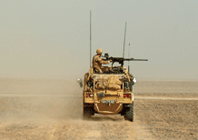
.Altair and Siemens software keep defence firm on track
Default


